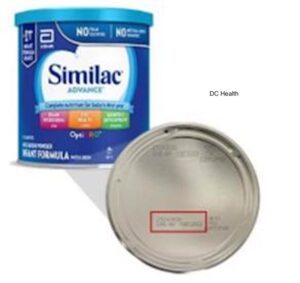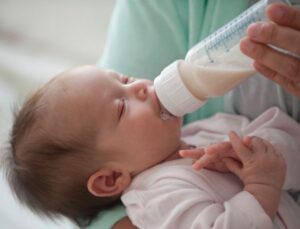If you’re lucky, the first time you ever heard the word “Cronobacter” was on a news segment last week. The foodborne pathogen with a name that sounds like a sci-fi villain doesn’t make headlines often. And that’s good. Because Cronobacter is only known for one thing – causing severe, often fatal, illness in newborn babies. And its main vehicle of transmission is powdered infant formula.
Last week, federal health officials announced that they are investigating a possible link between Similac, EleCare, and Alimentum powdered baby formulas and the illnesses of four infants who consumed them.
Three of the infants, in Minnesota, Ohio, and Texas, developed Cronobacter infections. One of them, another infant in Texas, developed a Salmonella infection. All four of the babies were hospitalized. The baby in Ohio passed away.

Cronobacter and Powdered Infant Formula, a Timeline
Cronobacter sakazakii, the strain associated with these illnesses, is one of the most virulent Cronobacter strains. Often isolated from infants with meningitis from Cronobacter, the high end of this strain’s mortality rate is 80 percent.
It is the strain associated with all of the illnesses in the timeline below. Before 2007, Cronobacter sakazakii was called Enterobacter sakazakii, but to simplify things, we are just using Cronobacter sakazakii.
Since the 1980s, when researchers first discovered the association between Cronobacter and powdered baby formula, most Cronobacter infections in infants have been linked epidemiologically to powdered infant formula, according to numerous studies. “When a source of a baby’s Cronobacter infection has been found, nearly all have been associated with consumption of reconstituted powdered infant formula,” the CDC states.
1950: Isolated from a container of dried milk, a strain of Cronobacter is documented for the first time. (1) Dried milk is the main ingredient in many baby formulas.
1953: Cronobacter is first isolated from a human clinical specimen. (1)
1958: The first case of neonatal meningitis from Cronobacter is documented. (1)
1965: The second documented case of meningitis from Cronobacter is documented at a county hospital in Odense, Denmark (1)
1983: For the first time, an association between Cronobacter and baby formula is described in a Dutch study of eight cases of neonatal meningitis and sepsis reported from 1977 to 1981. Only two of the babies survived. (2) (3)
1987: H.L. Muytjens, the lead researcher on the Dutch study, and a new team study the contamination rate of commercially prepared powdered formula products made in 35 different countries. They find Cronobacter is a common contaminant. (1) (4)
1988: At a neonatal intensive care unit in Memphis, Tennessee, the first Cronobacter outbreak in the U.S. occurs. (1) Four infants are sickened by formula contaminated during the manufacturing process. (5) Three of them had sepsis. All recovered.
1989: At a Porto, Portugal hospital, 187 patients had meningitis. Of those, 15 were neonates, 79 were infants, and 93 were 1–14 years old. There were 15 fatalities including two neonates who had been fed infant formula. (9)
1993-1998: From 1993 to 1998, four neonates at a Jerusalem hospital were infected with Cronobacter. The bacteria was also isolated from a blender used to mix and prepare infant formula. (9)
1998: In a neonatal intensive care unit at a Brussels hospital, 12 neonates contracted Cronobacter. All were fed powdered infant formula. Two patients, male twins, died. (9)
1999-2000: At the same Jerusalem hospital where four Cronobacter illnesses previously occurred, two more neonates were diagnosed with Cronobacter. Both had been fed powdered infant formula. (9)
2001: Another Cronobacter outbreak occurred at a neonatal intensive care unit in Tennessee, this time in Knoxville. The outbreak, associated with contaminated commercial powdered formula, included nine patients, one of whom developed meningitis and died. (1) (6)
2002: After the fatal Tennessee outbreak, the U.S Food and Drug Administration (FDA) issued a health alert to health care professionals. The alert described the risk of Cronobacter “infections in hospitalized newborn infants, particularly premature infants or other immuno-compromised infants fed powdered infant formulas. ”
2010: At a hospital in Queretaro, Mexico, two infants who were fed infant formula developed Cronobacter infections and suffered bloody diarrhea. Both recovered. (9)
2011: Four neonates and infants from four states – Florida, Illinois, Missouri, and Oklahoma – developed Cronobacter infections. Two of them died. All four of them consumed the same powdered formula.
2021: Four infants from three states – Minnesota, Ohio, and Texas – developed Cronobacter infections. All of them had consumed powdered infant formula. One of them died.
Powdered Infant Formula is not Sterile
not Sterile
The first commercial baby food was invented by famed German scientist Justus von Liebig, a pioneer of organic chemistry. In 1865, he patented the product, made from cow’s milk, wheat flour, malt flour, and potassium bicarbonate. In 1869, Leibig’s Soluble Infant Food became the first commercial baby food available in the U.S. (10) Nestle then developed a competing product, and many others followed suit, but it wouldn’t be until the 1950s when commercially produced infant formulas really hit their stride in the U.S. (11)
Today, North America represents a $5.6 billion market for the makers of baby formula. Globally, the market is more than $50 billion, with most of the growth coming from China.
But during all those decades since Liebig’s invention, as the formulas for formula got tweaked and touted, one thing didn’t change. Powdered infant formula never became a sterile product, meaning it can contain bacteria, such as Cronbacter and Salmonella. Liquid baby formula can be made sterile, but using current manufacturing processes, it is not possible to eliminate all bacteria from powdered infant formula.
That’s why the recommended preparation method for these powdered formulas stresses sterilizing bottles and nipples; using water that has boiled for a certain amount of time to make the formula; using the formula within a specific window of time; and discarding it immediately when the window has closed.
A Boycott that Changed Marketing Rules for Infant Formula
These recommendations pose a challenge for most parents, but in developing countries, where access to clean water is limited, it’s hard to imagine how they could be met. Still, those markets were opened.
By the early 1970s, reports emerged of formula-fed babies in developing countries dying of malnutrition because their impoverished parents were rationing the product that was too costly for them to afford.
In response, a Minnesota-based advocacy group called the Infant Formula Action Coalition (INFACT) started a boycott of Nestle, the maker of the products in question, in 1977. Soon other countries including Australia, Canada, New Zealand, and Europe joined the boycott.
The following year, the U.S. Senate held public hearings about marketing infant formula in developing countries. These findings led to the creation of the International Code of Marketing of Breastmilk Substitutes in 1981. This code includes restrictions that prevent manufacturers from advertising directly to consumers or giving out free promotional products, and requires them to disclose the health hazards and costs associated with formula. More than 30 years after the code was created, the U.S. remains one of a handful of countries that has yet to pass any legislation or regulation to implement it.
How Do We Know It’s Rare If We Don’t Track It?
Cronobacter is often described as rare. While it’s true that only a handful of cases are reported to the CDC each year, it’s also true that we’re not actively tracking them.

Food Safety Attorney and Food Poisoning Bulletin Publisher Eric Hageman
Cronobacter is not a “reportable disease” nationwide. Because it is not known to cause serious illness to the general population, it is not considered to be of great public health importance. So, doctors and labs aren’t required to report these infections to their state health departments who then report them to the CDC.
Minnesota is the only state in the country that requires reporting. The state’s epidemiologist specializing in Cronobacter told Food Poisoning Bulletin that Minnesota investigated two previous cases prior to 2019 and that the state typically sees one case every three to five years.
“Cronobacter can cause meningitis, septicemia, and necrotizing enterocolitis in infants. Often these infections are fatal,” said noted Food Safety Lawyer and Food Poisoning Bulletin Publisher Eric Hageman. “Given the risk of such dire outcomes, Cronobacter should be a reportable disease.”
What We Know About the Current Investigation
In its February 17 announcement of the current investigation, the FDA said all four of the infants who became ill are reported to have consumed powdered infant formula produced by Abbott Nutrition’s facility in Sturgis, MI.
During an inspection of that facility, the FDA collected environmental swabs and several of them were positive for Cronobacter. The FDA went on to say that it had found “adverse inspectional observations” at the plant and that a records review indicated that Abbott had previously found Cronobacter in the facility and destroyed product due to the presence of Cronobacter.
In its investigation announcement, the FDA advised consumers not to purchase or use any Similac, EleCare, or Alimentum powdered baby formula produced at the Sturgis plant. These items have the following identifiers on the bottom of the can:
- the first two digits of the code are 22 through 37 and
- the code on the container contains K8, SH, or Z2, and
- the expiration date is 4-1-2022 (APR 2022) or later.
Shortly after the FDA’s advisory was released, Abbott issued a recall for the formula produced at the Sturgis facility. The company stated that it conducts extensive quality checks on each completed batch of infant formula and that it tests all finished batches for pathogens before they can be released into commerce. It also clarified that the FDA’s environmental tests that were positive for Cronobacter were from non-product contact areas.
Cronobacter illnesses can be deadly for newborns. Seek immediate medical attention if your infant has symptoms of sepsis or meningitis including a pinprick rash, blotchy skin, high fever, shivering, fatigue, rapid breathing or difficulty breathing, unusual grunting sounds, refusal to feed, unusual movements, cold hands and feet and diarrhea.

Sources:
-
My 40-Year History with Cronobacter/Enterobacter sakazakii – Lessons Learned, Myths Debunked, and Recommendations, John J. Farmer, III https://www.ncbi.nlm.nih.gov/pmc/articles/PMC4662064/
-
Analysis of eight cases of neonatal meningitis and sepsis due to Enterobacter sakazakii. H L Muytjens, H C Zanen, H J Sonderkamp, L A Kollée, I K Wachsmuth, and J J Farmer, 3rd https://www.ncbi.nlm.nih.gov/pmc/articles/PMC270753/?page=1
-
Cronobacter spp. in Powdered Infant Formula SARAH NORBERG,1 CATHERINE STANTON,2,3 R. PAUL ROSS,2,3 COLIN HILL,1,2 GERALD F. FITZGERALD,1,2 AND PAUL D. COTTER2,3*
- Quality of powdered substitutes for breast milk with regard to members of the family Enterobacteriaceae.
J Clin Microbiol. 1988 Apr; 26(4):743-6.
- Enterobacter sakazakii infections in neonates associated with intrinsic contamination of a powdered infant formula. Simmons BP, Gelfand MS, Haas M, Metts L, Ferguson J.
- Enterobacter sakazakii Infections Associated with the Use of Powdered Infant Formula — Tennessee, 2001 https://www.cdc.gov/mmwr/preview/mmwrhtml/mm5114a1.htm
- fda.gov/inspections-compliance-enforcement-and-criminal-investigations/enforcement-story-archive/center-food-safety-and-applied-nutrition-cont-2002
- A Hidden Danger in Infant Formulas and Baby Foods: Enterobacter sakazakii Contamination http://dergi.fabad.org.tr/pdf/volum34/issue3/153-166.pdf
-
Outbreak History, Biofilm Formation, and Preventive Measures for Control of Cronobacter sakazakii in Infant Formula and Infant Care Settings, Monica Henry and Aliyar Fouladkhah https://www.ncbi.nlm.nih.gov/pmc/articles/PMC7181934/
- A concise history of infant formula (twists and turns included)https://www.contemporarypediatrics.com/view/concise-history-infant-formula-twists-and-turns-included
-
A History of Infant Feeding
https://www.ncbi.nlm.nih.gov/pmc/articles/PMC2684040/#:~:text=In%201865%2C%20chemist%20Justus%20von,food%20(Radbill%2C%201981).
Additional Sources
Cronobacter Species Contamination of Powdered Infant Formula and the Implications for Neonatal Health https://www.frontiersin.org/articles/10.3389/fped.2015.00056/full
Food Safety and Invasive Cronobacter Infections during Early Infancy, 1961–2018 https://www.ncbi.nlm.nih.gov/pmc/articles/PMC7181934/
Virulence and Antibiotic Resistance Profiles of Cronobacter sakazakii and Enterobacter spp. Involved in the Diarrheic Hemorrhagic Outbreak in Mexico https://www.frontiersin.org/articles/10.3389/fmicb.2018.02206/
Cronobacter Species in Powdered Infant Formula and Their Detection Methods https://www.ncbi.nlm.nih.gov/pmc/articles/PMC5960834/
 not Sterile
not Sterile



